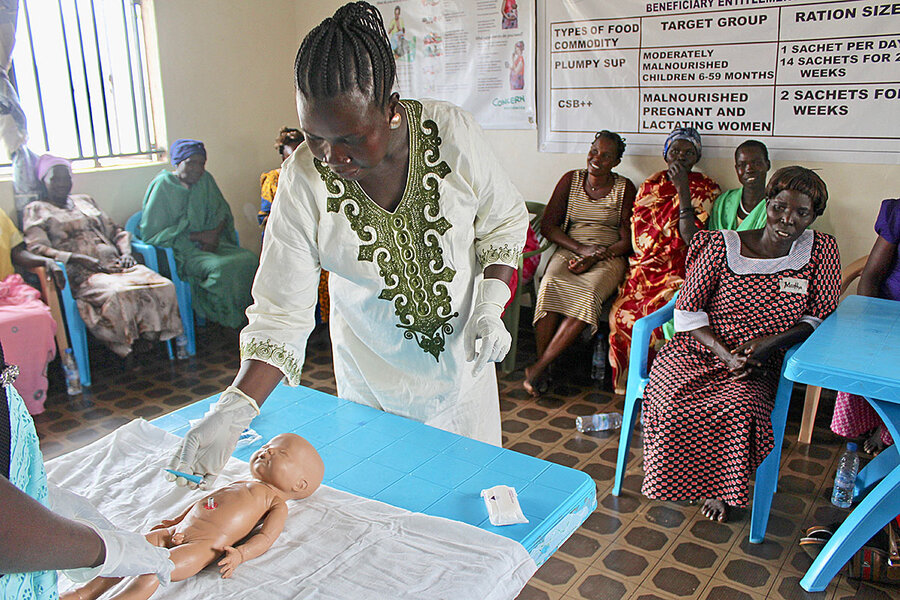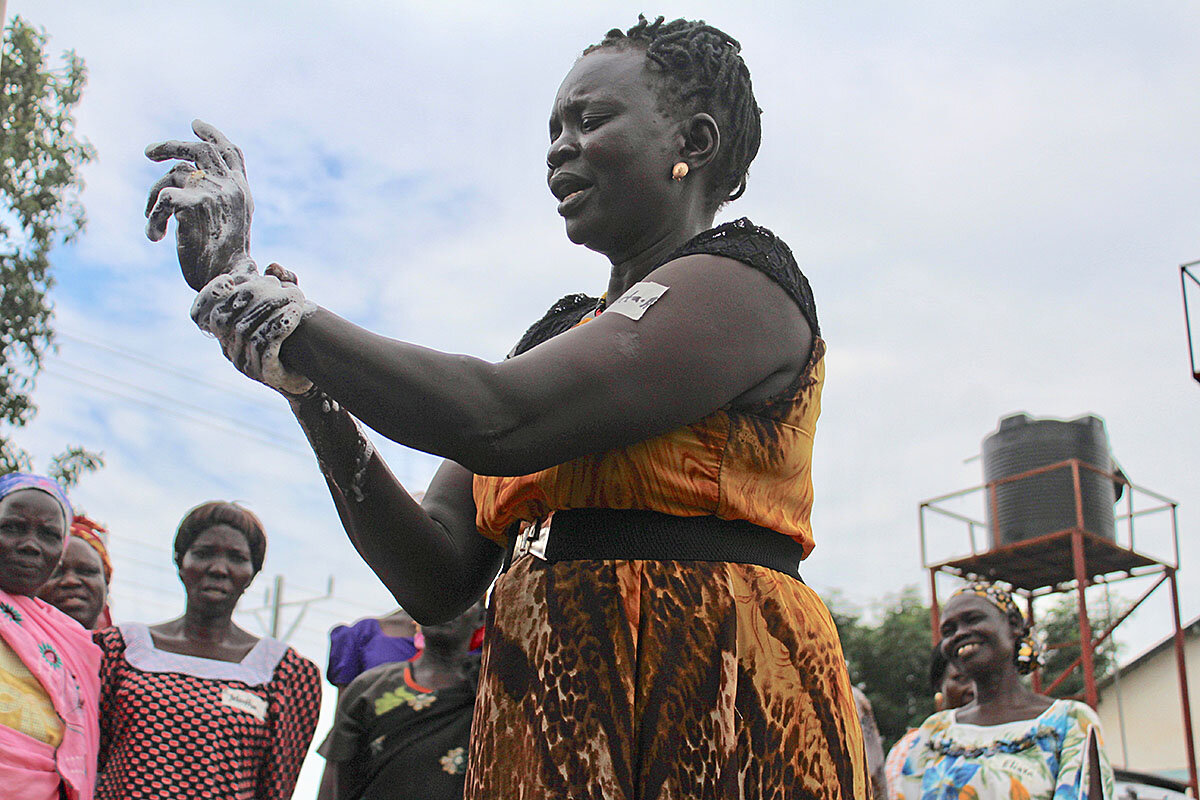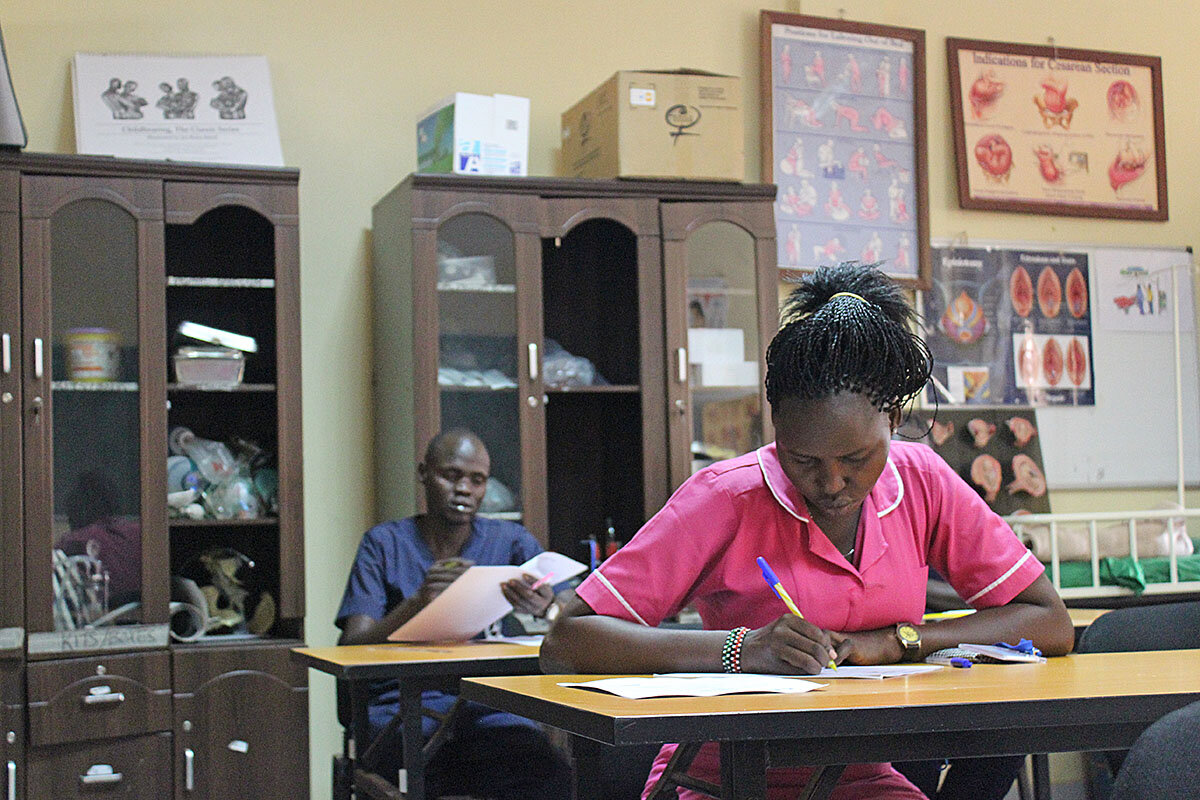South Sudan's midwives, boosted by aid, wonder how long donors will deliver
Loading...
| Juba, South Sudan
When South Sudan became independent in 2011, the country had just a few professionally trained midwives. Eight of them, to be precise. Donations flooded in to help the world’s youngest country deliver its youngest citizens safely. “Every day the quality of care was getting better. Every day we could do more than the day before it,” says Dr. Alice Pityia. But over the past five years, civil war has severely tested the world’s altruism here, as aid delivery grows more expensive and more dangerous and looters raid facilities. In maternity wards like Dr. Pityia’s, many employees wonder how much longer donations will keep coming for a place that seems, in many ways, to keep falling apart. But turning their attention elsewhere isn’t an option. When midwife Judith Draleru ran out of gloves during a delivery, she slipped plastic bags over her hands and carried on. Sometimes she works by the light of candles mothers have brought themselves. “Every day, despite all our challenges, you see that you are saving mothers and you are saving babies, so how can you stop?” she says. “I am the commander in chief of these babies’ lives.”
Why We Wrote This
Donors understandably want to make good investments – to put their dollars where they’ll work. But what does that mean in places that seem a step away from being dismissed as lost causes?
It was July 9, 2011, and just outside the walls of the maternity ward at the largest public hospital in the city, a country was being born.
Inside, meanwhile, babies were also being born, lots and lots of babies.
As Dr. Alice Pityia scrambled through her rounds, the wails of the newest citizens of the world’s newest country mixed with the cheers of the crowd outside. Throughout the delivery ward, mothers sprawled on the thin metal beds talked names.
Why We Wrote This
Donors understandably want to make good investments – to put their dollars where they’ll work. But what does that mean in places that seem a step away from being dismissed as lost causes?
Independence, she heard one suggest. Yes, that was a good name for a girl. Elegant and strong.
Salva Kiir, offered another, after the man who had been their president for all of 20 minutes.
“You have never seen mothers so happy,” says Dr. Pityia, remembering her shift at the Juba Teaching Hospital that Saturday, the day South Sudan became independent from Sudan.
But medical staff, too, were hopeful. South Sudan was now on the map – literally and metaphorically. That meant faraway governments were suddenly ready to cut big checks in the name of making life better in the world’s youngest country. In scrappy maternity wards like the one in Juba, where power flickered on and off and nurses frequently asked patients to buy gloves and needles, money poured in.
“Every day, the quality of care was getting better. Every day, we could do more than the day before it,” says Pityia. The maternity ward where she worked was renovated, and next to it, the country’s first neonatal intensive care unit sprung up, full of incubators and tiny cradles. South Sudanese doctors and nurses who had scattered around the globe began returning, ready to work.
Then came the fighting.
Since 2013, a civil war has severely tested the strength of the world’s altruism here, making South Sudan one of the most expensive places to deliver aid, and one of the most dangerous. Over the past five years, global donors have given an average of more than a billion dollars annually to South Sudan, most of it for short-term humanitarian assistance.
“The cost of doing business here has become enormous,” says Mary Otieno, the South Sudan country representative for the United Nations Population Fund (UNFPA). “All of this creates a lot of uncertainty and therefore donors are not willing to invest in the long term.”
In maternity wards like Pityia’s, many began to worry for the future. They still do. How much longer, they wonder, will the donors with fat checkbooks keep caring about South Sudan before they simply give up? How long can you convince the world to keep giving to a place that seems, in many ways, to keep falling apart?
Momentum, dashed
When South Sudan became independent, many donors immediately turned their attention to its health system, which had been decimated by five decades of conflict. They were particularly concerned with one statistic: Of every 100,000 women who gave birth in South Sudan, more than 2,000 died. It was one of the highest maternal mortality rates in the world – about 150 times the rate in the United States, and more than 500 times the rate in Finland at the time. Fewer than 1 in 5 women had a trained professional to assist them when they gave birth.
Funders pledged money to train midwives – the country had only eight at independence – and kit out health facilities. South Sudanese doctors and nurses returned to quite literally deliver their country its next generation.
“I felt like, let me come do this for my country,” says Pityia, who had grown up in Khartoum, the capital of Sudan. And anyway, the money wasn’t bad – she made 4,000 South Sudanese pounds, then around $2,000, a month.
But in December 2013, less than 2-½ years after she celebrated independence day in the maternity ward, forces loyal to South Sudan’s president, Salva Kiir, clashed with the troops of its vice president, Riek Machar. The conflict quickly spiraled into a full-blown civil war. Oil production – the source of 95 percent of government revenue – ground to a halt.
As South Sudan’s government struggled to keep pace with its bills, it began printing more money, tanking the value of the currency. (Today, Pityia’s monthly pay is worth around $30, and she makes most of her money doing consulting on the side in private clinics.) Nurses and midwives, paid even less than the doctors, began hassling patients for cash. Next, the hospital began to run out of medicine, then basic supplies.
Across the country, meanwhile, forces on both sides attacked and looted clinics. By 2016, half the medical facilities in the country had been destroyed, according to government estimates.
Even in Juba, the capital, women often died giving birth at home at night because they were afraid to cross notoriously dangerous government checkpoints to reach nearby hospitals. By 2016, the government estimated that only 9 percent of women were giving birth with the help of a doctor or midwife in a health facility.
'Commander in chief of these babies' lives'
Still, at the Teaching Hospital in Juba, the staff did what they could. Judith Draleru, a Ugandan midwife working for UNFPA, rallied her colleagues to help clean the wards, since the cleaners, whose salaries were now worth only a few dollars a month, had mostly stopped showing up to work. When a patient needed blood, Ms. Draleru asked her friends to donate, or she did it herself. When there were no gloves available to assist with a delivery, she slipped plastic bags over her hands and carried on, sometimes working by the light of candles the mothers had brought themselves.
“Every day, despite all our challenges, you see that you are saving mothers and you are saving babies, so how can you stop?” she says. “I am the commander in chief of these babies’ lives.”
But for many others, the question is flipped – without money, without supplies, without support, how long will it be possible to go on?
At the Teaching Hospital, the next potential casualty is an ambitious midwife training program. Since 2012 the program – which is funded by the Swedish and Canadian governments – has trained more than 600 midwives here, and scattered them across the country.
“What we’ve done so far is just a drop in the ocean, so we are hopeful the program will find a way to continue,” says Ms. Otieno of UNFPA, which runs the midwife training course. “But there will not be a new first year class next year unless we get another donor.”
Like many here, she’s hopeful that a recent peace agreement will bring enough stability to convince donors they can fund long-term projects here. Hopeful that after seven years, the world is not yet ready to give up on South Sudan.
But for the South Sudanese themselves, forgetting about this place has never been an option. “If we leave, this country doesn’t have a future,” says Pityia, shrugging. All her life, she says, she was waiting to have her own country. Now that she does, she isn’t about to leave it.
Across town, meanwhile, in a tiny clinic in the Gumbo neighborhood, Draleru is helping train a group of traditional birth attendants – a kind of catch-all term for the women neighbors know to call when one of them goes into labor. Together, the attendants practice basic hygiene: washing their hands and snipping umbilical cords with clean, sharp razors. These trainings are essential, Draleru says, because most mothers never make it to a hospital.
“Why do I keep doing this? Because you cannot say no to a woman in your community who needs you,” says Brigina Wasuk, one of the students, who has been delivering babies for more than a decade in her Juba neighborhood. “It’s not an option for us.”
Silvano Yokwe contributed reporting. Support for the reporting of this story was provided by the International Women’s Media Foundation.










